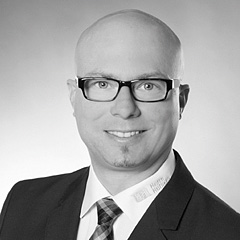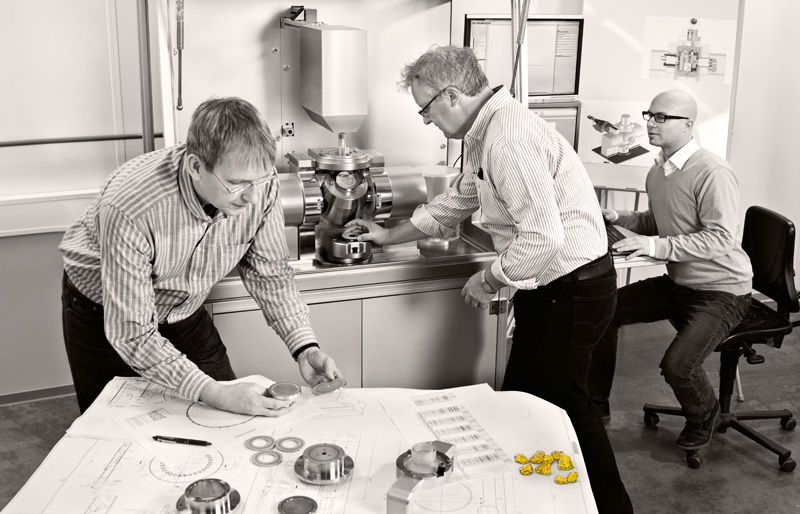Peter Claußnitzer, CTO at Harro Höfliger, carefully considers the concept of innovation: “The over-use of buzz words dilutes their core and degrades them into catch words. Most new products are not really innovative. Progressive, different and worthwhile are necessary but insufficient conditions for an innovation. An innovation should fundamentally change something,” Peter Claußnitzer emphasizes. As a possible example for the near future he names the technology of Linear Motion Systems (LMS), such as Beckhoff XTS or Magnemotion linear transport systems, with independently driven workpiece carriers. The reason: “Utilizing these transport systems essentially changes the design and the philosophy of a machine. That is why their use would be a genuine product innovation.”
„New approaches must be introduced in close consultation with the customer. Because the customer appreciates creativity but does not like negative surprises.“Thomas Weller, CEO
One organizational innovation, still in effect today, is the incorporation of a “pharmacist” into the company structure. The resulting “Pharma Services” department at Harro Höfliger is the basis for many successful projects, and guarantees increased process reliability. The Pharma Services experts guide the customers in the selection, development and optimization of the processes from product infeed to packaging. The first step is the characterization of active ingredient-containing original formulations, and the determination of the optimal dosing principle using a comparative product database. Utilizing test setups, critical processes are verified and tested well in advance. Finally, clean rooms make it possible to operate the new system with the original product under future environmental conditions. Therefore, Harro Höfliger not only builds machines, but is frequently an integral part of the development phase of new drugs.
(Illustration: Bernd Schifferdecker)
Beyond the daily routine, new ideas constantly emerge regarding machines, systems and processes. So that they are not lost, Achim Wolf has set up the EIS (Engineering & Innovation Services) department at the Allmersbach im Tal headquarters. Their task is to systemize, structure and efficiently develop the process from the initial idea to market readiness. Thus, ideas with potential for innovation do not end up in some desk drawer, but are consistently moved forward in a controlled process and in multiple phases.
“Most new products are not really innovative. A true innovation should fundamentally change something.“Peter Claußnitzer, CTO
Innovation management as a systematic process, with transparent decisions and close project control is a building block of Harro Höfliger’s Strategy 2020. CEO Thomas Weller explains: “Our customers come to us because they know that we, as technology leaders, find the right solution for their particular task – even beyond the beaten path.” It is therefore imperative that every market trend is recognized and analyzed at an early stage. However, emphasizes Thomas Weller, “new approaches must be introduced in close consultation with the customers. Because the customer appreciates creativity but does not like negative surprises.” The key is the so-called co-innovation with the customer. For Peter Claußnitzer this has become the norm at Harro Höfliger: “Many good solutions are created together with our customers. We motivate and encourage each other to achieve excellence.”
(Photo: Helmar Lünig, Bernd Schifferdecker)
More than 1,000 capable creative mindes
Achim Wolf manages the innovation management team at Harro Höfliger. A conversation about tasks, challenges and successes.
 What responsibilities does your team have, Mr. Wolf?
What responsibilities does your team have, Mr. Wolf?
We are the first stop for an idea to become reality. After all, our company now has well over 1,000 proficient creative minds on the payroll – everyone can come to us with his or her sparking idea. First, we ensure that no flash of inspiration is lost. After all, there can be a real innovation behind every idea.
Do you also ensure a controlled process?
In four steps, we channel the flow from idea to innovation. First, an interdisciplinary team examines the feasibility of an idea. The innovation steering committee uses this expert opinion as a basis for whether or not an idea is pursued as a project. If in the next step, the project suitability is confirmed, the steering committee decides whether and in which application context the idea should be further developed. Next, it is determined which machine can be used for a new technology, or for which target customers the innovation can be considered.
How do you provide support to the originator of the idea along the way?
In the classic role as a coach, we clear the way. We set priorities, provide the necessary resources, and ensure continuous communication regarding the project status. With full support from management, we can also identify other employees who can function as promoters at the appropriate time. Last but not least, we make decisions transparent and ensure close project control.
Are there examples in which innovation management has already proven itself?
The XTray, a universal concept for the delivery of surgical sutures, is one example. Likewise, our DiscFiller – a table unit that can be used to fill up to 60 cavities of a disc with inhalation powder in one dosing cycle – is the result of our dedicated innovation management.
Download this article as PDF file
Photos: Janine Kyofsky, Tom Philippi, Bernd Schifferdecker


